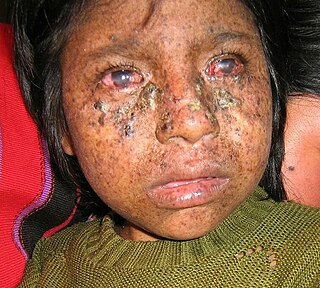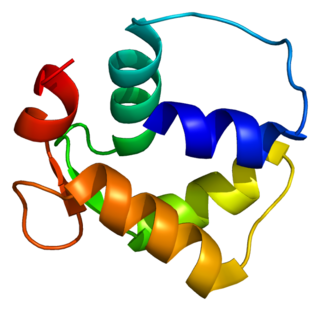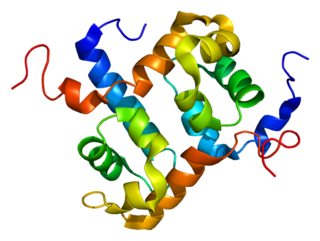UV excision repair protein RAD23 homolog B is a protein that in humans is encoded by the RAD23B gene. [5] [6]
UV excision repair protein RAD23 homolog B is a protein that in humans is encoded by the RAD23B gene. [5] [6]
The protein encoded by this gene is one of two human homologs of Saccharomyces cerevisiae Rad23, a protein involved in nucleotide excision repair (NER). This protein was found to be a component of the protein complex that specifically complements the NER defect of xeroderma pigmentosum group C (XP-c) cell extracts in vitro. This protein was also shown to interact with, and elevate the nucleotide excision activity of 3-methyladenine-DNA glycosylase (MPG), which suggested a role in DNA damage recognition in base excision repair. This protein contains an N-terminal ubiquitin-like domain, which was reported to interact with 26S proteasome, and thus this protein may be involved in the ubiquitin mediated proteolytic pathway in cells. [7]
The complex of XPC-RAD23B is the initial damage recognition factor in global genomic nucleotide excision repair (GG-NER). XPC-RAD23B recognizes a wide variety of lesions that thermodynamically destabilize DNA duplexes, including UV-induced photoproducts (cyclopyrimidine dimers and 6-4 photoproducts ), adducts formed by environmental mutagens such as benzo[a]pyrene or various aromatic amines, certain oxidative endogenous lesions such as cyclopurines and adducts formed by cancer chemotherapeutic drugs such as cisplatin. The presence of XPC-RAD23B is required for assembly of the other core NER factors and progression through the NER pathway both in vitro and in vivo. [8] Although most studies have been performed with XPC-RAD23B, it is part of a trimeric complex with centrin-2, a calcium-binding protein of the calmodulin family. [8]
The protein expression level of RAD23B can be epigenetically repressed, either by promoter methylation of the RAD23B gene [9] [10] or by either of two microRNAs (miR-744-3p [11] or miR-373 [12] ).
A deficiency in expression of a DNA repair gene increases the risk for cancer (see Deficient DNA repair in carcinogenesis). The expression of RAD23B is reduced in tumor tissue of women with breast cancer. [13] A low percentage of RAD23B positive nuclei in high grade breast cancer was also observed. [14]
RAD23B was substantially reduced by promoter methylation in a cell line derived from multiple myeloma. [9] and reduced by promoter methylation in a small proportion of non-small cell lung cancer (NSCLC) tumours. [10]
RAD23B appears to be one of 26 DNA repair genes that are epigenetically repressed in various cancers (see Cancer epigenetics).
RAD23B has been shown to interact with PSMD4 [15] and Ataxin 3. [16]

Xeroderma pigmentosum (XP) is a genetic disorder in which there is a decreased ability to repair DNA damage such as that caused by ultraviolet (UV) light. Symptoms may include a severe sunburn after only a few minutes in the sun, freckling in sun-exposed areas, dry skin and changes in skin pigmentation. Nervous system problems, such as hearing loss, poor coordination, loss of intellectual function and seizures, may also occur. Complications include a high risk of skin cancer, with about half having skin cancer by age 10 without preventative efforts, and cataracts. There may be a higher risk of other cancers such as brain cancers.

Nucleotide excision repair is a DNA repair mechanism. DNA damage occurs constantly because of chemicals, radiation and other mutagens. Three excision repair pathways exist to repair single stranded DNA damage: Nucleotide excision repair (NER), base excision repair (BER), and DNA mismatch repair (MMR). While the BER pathway can recognize specific non-bulky lesions in DNA, it can correct only damaged bases that are removed by specific glycosylases. Similarly, the MMR pathway only targets mismatched Watson-Crick base pairs.

XPB is an ATP-dependent DNA helicase in humans that is a part of the TFIIH transcription factor complex.
A DNA repair-deficiency disorder is a medical condition due to reduced functionality of DNA repair.
Richard D. Wood is an American molecular biologist specializing in research on DNA repair and mutation. He is known for pioneering studies on nucleotide excision repair (NER), particularly for reconstituting the minimum set of proteins involved in this process, identifying proliferating cell nuclear antigen (PCNA) as part of the NER complex and identifying mammalian repair polymerases.

ERCC2, or XPD is a protein involved in transcription-coupled nucleotide excision repair.
Transcription factor II H (TFIIH) is an important protein complex, having roles in transcription of various protein-coding genes and DNA nucleotide excision repair (NER) pathways. TFIIH first came to light in 1989 when general transcription factor-δ or basic transcription factor 2 was characterized as an indispensable transcription factor in vitro. This factor was also isolated from yeast and finally named TFIIH in 1992.

UV excision repair protein RAD23 homolog A is a protein that in humans is encoded by the RAD23A gene.

DNA damage-binding protein 2 is a protein that in humans is encoded by the DDB2 gene.
The enzyme DNA-(apurinic or apyrimidinic site) lyase, also referred to as DNA-(apurinic or apyrimidinic site) 5'-phosphomonoester-lyase or DNA AP lyase catalyzes the cleavage of the C-O-P bond 3' from the apurinic or apyrimidinic site in DNA via β-elimination reaction, leaving a 3'-terminal unsaturated sugar and a product with a terminal 5'-phosphate. In the 1970s, this class of enzyme was found to repair at apurinic or apyrimidinic DNA sites in E. coli and in mammalian cells. The major active enzyme of this class in bacteria, and specifically, E. coli is endonuclease type III. This enzyme is part of a family of lyases that cleave carbon-oxygen bonds.

Xeroderma pigmentosum, complementation group C, also known as XPC, is a protein which in humans is encoded by the XPC gene. XPC is involved in the recognition of bulky DNA adducts in nucleotide excision repair. It is located on chromosome 3.

26S proteasome non-ATPase regulatory subunit 4, also as known as 26S Proteasome Regulatory Subunit Rpn10, is an enzyme that in humans is encoded by the PSMD4 gene. This protein is one of the 19 essential subunits that contributes to the complete assembly of 19S proteasome complex.

DNA repair protein complementing XP-A cells is a protein that in humans is encoded by the XPA gene.

DNA excision repair protein ERCC-6 is a protein that in humans is encoded by the ERCC6 gene. The ERCC6 gene is located on the long arm of chromosome 10 at position 11.23.

DNA repair protein complementing XP-G cells is a protein that in humans is encoded by the ERCC5 gene.

DNA damage-binding protein 1 is a protein that in humans is encoded by the DDB1 gene.

Centrin-2 is a protein that in humans is encoded by the CETN2 gene. It belongs to the centrin family of proteins.

ERCC4 is a protein designated as DNA repair endonuclease XPF that in humans is encoded by the ERCC4 gene. Together with ERCC1, ERCC4 forms the ERCC1-XPF enzyme complex that participates in DNA repair and DNA recombination.

DNA excision repair protein ERCC-8 is a protein that in humans is encoded by the ERCC8 gene.

DNA polymerase eta, is a protein that in humans is encoded by the POLH gene.
{{cite journal}}: CS1 maint: DOI inactive as of January 2024 (link)